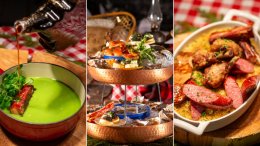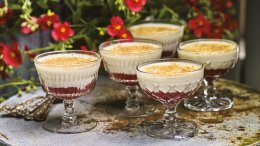If you’re entertaining this holiday season, there really is no better way to welcome your guests (or scent your home) than with a glass of warm and aromatic mulled wine! And while mulled wine is a holiday tradition for many today, conjuring up images of a Charles Dickens novel with people all bundled up, skating around on a frozen pond while the sound of joyous carollers can be heard in the distance, it was the Ancient Greeks who first began heating and sweetening their leftover wine. Now, it may have been fine for them to use any old wine they had laying around (note that it is not within the Greek culture to let anything go to waste, especially not a drink), but we live in modern times and I feel very strongly that the mulled wine we drink today should be made with wine that is as delicious spiced and sweetened as it is on its own.
When making mulled wine, you want to make sure that the red wine you choose has enough body and structure to stand up to the powerful flavours of cinnamon, clove and orange peel. I also like to add vermouth; with vermouth having similar bitter and spice elements, I find it elevates the flavours and brings an added complexity to your mulled wine. Below are a few of my favourite reds that are also really affordable--so you won’t feel guilty altering them--as well as an amazing Canadian vermouth that I’m sure will be a welcome addition to your back bar.
One of the great things about mulled wine is that you can prepare it in advance and reheat as necessary. Keep in mind that by reheating, you will lose some of the alcohol in the process. If you want to retain some of the alcohol and give everyone a “holiday glow”, you should only reheat for a few minutes, just long enough to get it to a desired temperature. You can also add a few more ounces of brandy to help bring the alcohol levels back up.
2015 Vineland Cabernet Franc ($14.95), Niagara Peninsula, ON
Cabernet franc is the perfect varietal for our cool Canadian climate. With an inherent “green” character (think fresh herbs, like thyme and parsley) married with ripe red raspberry, black pepper and just a hint of sweet tobacco, it is great as a base for mulled wine. And with its firm tannin structure and bright acidity, it will also pair perfectly with rare red meats like rack of lamb or flat iron steak.
Stags Hollow Heritage Block 2013 ($22), Okanagan Valley, BC
This Bordeaux blend from the Okanagan is the perfect canvas for mulling spices and also serves as a great standalone wine to pour for your guests throughout the evening. Cabernet sauvignon and Cabernet franc deliver ripe cherry and berry notes with bright acidity, while merlot brings richness to the wine and malbec brings just a hint of savouriness and body. The deft use of oak helps to smooth out the tannin and marry the flavours, delivering a full bodied, uncomplicated wine that is sure to please every palate.
Chateau Des Charmes Cabernet Sauvignon ($15.95), Niagara-on-the-Lake, ON
Chateau des Charmes is known for its sustainable winemaking practices and old world influence. Its entry level Cabernet sauvignon delivers classic notes of blackcurrant, licorice and tobacco while the use of French oak barrels helps bring out notes of clove, dark chocolate and cedar. Cabernet sauvignon is known for its masculine tannin structure and full body, allowing it to carry the intense flavour from the mulling spices with ease.
Dillon’s Small Batch Vermouth ($19.95), Beamsville, ON
Vermouth might not be the first thing you reach for when you’re making mulled wine, but you should absolutely think about adding it to your family recipe. Vermouth (or aromatized wine) has flavouring agents that are also found in mulled wine, like bitter orange and cinchona bark (which is very similar to cinnamon). The addition of vermouth will help to bring out the warming spices while adding complexity and layering on the mulled wines existing bitter and sweet notes.
Mulled wine recipe
1 orange, zested
2 sticks cinnamon
2 tbsp whole cloves
1/4 tsp freshly grated nutmeg
1 vanilla bean, split
1 750 mL bottle red Wine
375 mL brandy
1/3 cup honey
6 oz. sweet vermouth
1 orange, sliced (optional garnish)
Using a piece of cheesecloth and butchers twine, tie up the orange zest, cinnamon, cloves, nutmeg and vanilla bean into a little bundle.
In a large saucepan over low heat, add the red wine, brandy, honey and bundle of spices. Allow everything to simmer for one hour so that the flavours can develop. Just before removing from heat, add vermouth. (Adding Vermouth at the very end allows the vermouth to maintain its flavour intensity.)
Ladle wine into mugs and, if you like, garnish with slices of orange.













